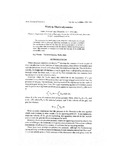Please use this identifier to cite or link to this item:
http://hdl.handle.net/10311/225Full metadata record
| DC Field | Value | Language |
|---|---|---|
| dc.contributor.author | Ahmad, J. | |
| dc.contributor.author | Ddamba, W.A.A. | |
| dc.date.accessioned | 2008-09-22T08:19:52Z | |
| dc.date.available | 2008-09-22T08:19:52Z | |
| dc.date.issued | 2006 | |
| dc.identifier.citation | Ahmad, J. & Ddamba, W.A.A. (2006) Work in Thermodynamics, Asian Journal of Chemistry, Vol. 18, No. 3, pp. 1995-2001 | en |
| dc.identifier.issn | 0970-7077 | |
| dc.identifier.uri | http://hdl.handle.net/10311/225 | |
| dc.description.abstract | The expression for mechanical work obtained in the expansion of a gas commonly used in physical chemistry textbooks is critically examined. The mathematical form of the first law of thermodynamics is arrived at by a procedure that is consistent with the common definition of mechanical work. The treatment is extended to explain the concept of reversible and irreversible work. | en |
| dc.language.iso | en | en |
| dc.publisher | Chemic Publishing Co., http://www.asianjournalofchemistry.com/ | en |
| dc.subject | Thermodynamics | en |
| dc.subject | Work | en |
| dc.subject | Heat | en |
| dc.title | Work in Thermodynamics | en |
| dc.type | Article | en |
| Appears in Collections: | Research articles (Dept of Chemistry) | |
Files in This Item:
| File | Description | Size | Format | |
|---|---|---|---|---|
| Work in thermodynamics.pdf | 1.17 MB | Adobe PDF |  View/Open | |
| license.txt | 1.95 kB | Text | View/Open |
Items in DSpace are protected by copyright, with all rights reserved, unless otherwise indicated.
